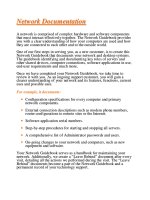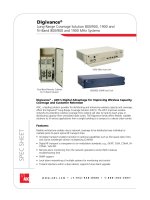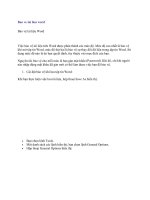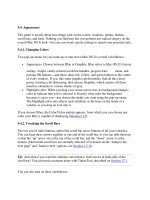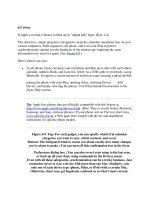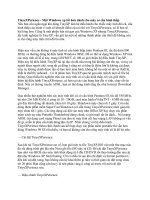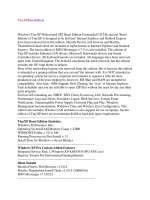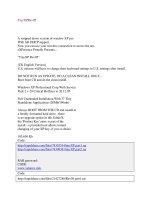Tài liệu Preface doc
Bạn đang xem bản rút gọn của tài liệu. Xem và tải ngay bản đầy đủ của tài liệu tại đây (89 KB, 6 trang )
This is the Title of the Book, eMatter Edition
Copyright © 2002 O’Reilly & Associates, Inc. All rights reserved.
ix
Preface
Master one single topic, and everything becomes clearer.
The field of network security is a huge subject. To be a network security expert, you
must be an expert on routers, switches, hubs, firewalls, intrusion detection systems
(IDS), servers, desktops, email, HTTP, instant messages, sniffers, and a thousand
other topics. There are many books on network security, and the good ones tend to
be tomes of 1000+ pages that are intimidating even to their authors. This book takes
the opposite approach. It takes a single, but vitally important, topic and expands on
it. Routers are your first line of defense. If they are compromised, everything else is
compromised. This book describes how to secure your routers. Once you learn how
to secure them, routers can protect the rest of your network.
To reemphasize, this is not a book on network security; there are hundreds of those
already in print. You will not find long discussions on firewalls, Virtual Private Net-
works (VPNs), network IDS systems, or even access lists (ACLs). This book is more
fundamental than that. This book shows how to harden the foundation of your net-
work—the router. Once you have mastered the information in this book, you will
find that your ability to build firewalls and configure IDS systems will increase. You
will be building on a secure foundation.
Organization
This book consists of 11 chapters and 5 appendixes. At the end of most chapters is a
checklist summarizing the hardening techniques described in that chapter.
Appendix A provides a complete hardening checklist made up of the chapter check-
lists. The book is designed to be read either straight through for those new to router
security, or a chapter at a time for those interested in specific topics. I recommend,
however, that before reading the book, you review the checklist provided in
Appendix A. This checklist will give you a good feel for the information covered in
,ch00.23088 Page ix Friday, February 15, 2002 2:52 PM
This is the Title of the Book, eMatter Edition
Copyright © 2002 O’Reilly & Associates, Inc. All rights reserved.
x
|
Preface
each chapter and familiarize you with the scope of the book. Here is a brief descrip-
tion of what each chapter and appendix covers.
Chapter 1, Router Security, addresses the importance of router security and where
routers fit into an overall information security plan. Additionally, this chapter dis-
cusses which routers are the most important to secure and how secure routers are
necessary (and often overlooked) parts of both firewall design and the overall infor-
mation security strategy of a company.
Chapter 2, IOS Version Security, discusses security issues involving the router IOS
software. It outlines current IOS revisions, shows how to determine current IOS ver-
sions, and details the importance of running a current IOS.
Chapter 3, Basic Access Control, discusses the standard ways to access a Cisco router,
the security implications of each of these methods, and how to secure basic Cisco
router access. These methods include console, VTY, AUX, and HTTP access controls.
Chapter 4, Passwords and Privilege Levels, discusses the three ways that Cisco rout-
ers store passwords and the security implications of each method. This chapter con-
tinues to discuss the router’s default security levels and shows how to modify these
levels to increase the security and accountability on your routers.
Chapter 5, AAA Access Control, discusses how to use the advanced AAA authentica-
tion and authorization configuration for Cisco routers. It also shows how to use a
network access server running RADIUS or TACACS+ to control these services on
the router.
Chapter 6, Warning Banners, discusses the importance of having warning banners on
routers. This chapter not only talks about the need to have banners, but also pre-
sents legal dos and don’ts for security banners. Finally, the chapter provides an
example recommended banner to use on Cisco routers.
Chapter 7, Unnecessary Protocols and Services, discusses the unnecessary services
that are commonly run on Cisco routers. Many of these services are enabled by
default, and this chapter explains why services such as HTTP, finger, CDP, echo, and
chargen are dangerous and details how to turn them off.
Chapter 8, SNMP Security, demonstrates how to disable SNMP or configure it
securely. It presents the differences between SNMP Versions 1, 2, and 3; talks about
read-only versus read-write access; and shows how to use access lists to limit SNMP
access to only a few specific machines.
Chapter 9, Secure Routing and Antispoofing, discusses routing protocol security. Spe-
cifically, it discusses how to add security to RIP, OSPF, EIGRP, and BGP. These
routing protocols allow authentication to prevent fake routing updates. The chapter
also presents the importance of antispoofing filters and how to perform ingress and
egress filtering using CLs on older routers and Cisco’s RPF and CEF antispoofing
mechanisms on newer ones.
,ch00.23088 Page x Friday, February 15, 2002 2:52 PM
This is the Title of the Book, eMatter Edition
Copyright © 2002 O’Reilly & Associates, Inc. All rights reserved.
Preface
|
xi
Chapter 10, NTP, discusses NTP and how to use it to make sure all routers have the
exact same time. This chapter discusses the importance of having the time on all
your routers and logging servers synchronized and provides examples of how to con-
figure a Cisco router to use NTP time services.
Chapter 11, Logging, discusses how Cisco routers perform logging and why logging is
important. The chapter then demonstrates why and how to manipulate logging buff-
ers, how to configure routers to use syslog, and when to do ACL violation logging.
Appendix A, Checklist Quick Reference, allows you to secure your Cisco routers and
verify that important security issues have been addressed. The checklist is presented
in a manner that makes it easy to quickly refer back to the chapter addressing the
items outlined in the checklist reference. Finally, this appendix briefly talks about
using the checklist to harden and audit Cisco routers.
Appendix B, Physical Security, talks about the importance of physically securing your
routers. It presents common physical vulnerabilities and discusses how to overcome
them.
Appendix C, Incident Response, gets you thinking about how to react when a break-
in is discovered. The goal of this chapter is not to provide an exhaustive explanation
of incident response, but to provide emergency guidelines that you can follow when
an incident occurs.
Appendix D, Configuration Examples, provides common Cisco router configuration
examples that combine the examples throughout the book.
Appendix E, Resources, provides a list of resources that you might find useful if you
need to brush up on ACLs, network access protocols such as TACACS or RADIUS,
and services such as SNMP or syslog.
Audience
This book assumes you are already familiar with configuring, administering, and
troubleshooting Cisco routers. A CCNA should be comfortable with the contents of
each chapter. A CCNP or above will probably want to first turn to the checklist pro-
vided in Appendix A. To get the most out of this book, you should be familiar with:
• Accessing your router through the console and VTYs
• Using TCP/IP and subnet masks
• Configuring your router from the command line
• Upgrading your IOS
• Configuring standard and extended ACLs
• Routing protocols such as RIP, IGRP, and OSPF
,ch00.23088 Page xi Friday, February 15, 2002 2:52 PM
This is the Title of the Book, eMatter Edition
Copyright © 2002 O’Reilly & Associates, Inc. All rights reserved.
xii
|
Preface
Conventions Used in This Book
The following formatting conventions are used throughout this book:
• Italic is used for commands, passwords, error messages, filenames, emphasis,
and the first use of technical terms.
•
Constant width
is used for IP addresses and router configuration examples.
•
Constant width italic
is used for replaceable text.
•
Constant width bold
is used for user input.
This icon indicates a note or tip.
This icon indicates a warning.
How to Contact Us
Please address comments and questions concerning this book to the publisher:
O’Reilly & Associates, Inc.
1005 Gravenstein Highway North
Sebastopol, CA 95472
(800) 998-9938 (in the United States or Canada)
(707) 829-0515 (international/local)
(707) 829-0104 (fax)
There is a web site for this book, which lists errata, examples, or any additional
information. You can access this page at:
/>To comment or ask technical questions about this book, send email to:
For more information about books, conferences, resource centers, and the O’Reilly
Network, see the O’Reilly web site at:
,ch00.23088 Page xii Friday, February 15, 2002 2:52 PM
This is the Title of the Book, eMatter Edition
Copyright © 2002 O’Reilly & Associates, Inc. All rights reserved.
Preface
|
xiii
Acknowledgments
First, always, is my wife Abigail Akin. Neither of us knew how hard this would be,
but it was her encouragement (and occasional kick in the pants) that gave me the
courage and discipline to write and finish this book. Honey, this first book is for you.
Second, for his near infinite patience, is Jim Sumser, my editor. It was Jim who took
a chance on an unknown author. He pushed me when I needed it and always had a
word of praise to keep me on track just when I was about to throw my computer out
the window.
My technical reviewers gave invaluable input: Ian J. Brown, CCIE #3372, Mark
Jackson, CCIE #4736, and Elsa Lankford. Ian and Mark kept me towing the line
technically, while Elsa kept me from getting bogged down in details, missing the for-
est for the trees. Ian and Mark, the configuration examples in Appendix Dare for
you, and, Elsa, the resources in Appendix E are yours.
Also, my friends in law enforcement: thanks to Steve Edwards from the Georgia
Bureau of Investigation and Cassandra Schansman, Georgia’s Assistant Attorney
General, for both their support and review of Appendix C. Thanks to Patrick Gray
from the FBI’s Atlanta Computer Crimes Squad for providing the warning banner in
Chapter 6.
Next, Jeff Crabtree, my former boss and long-time friend. He gave me my start in
information technology and has supported me, many times at his own expense, for
almost a decade. I owe you and Lisa some serious margaritas.
Finally, the two people who have taught me that integrity and love are the most
important parts of being successful—my father Morgan Akin and my mother Cathy
Coulmas.
,ch00.23088 Page xiii Friday, February 15, 2002 2:52 PM
